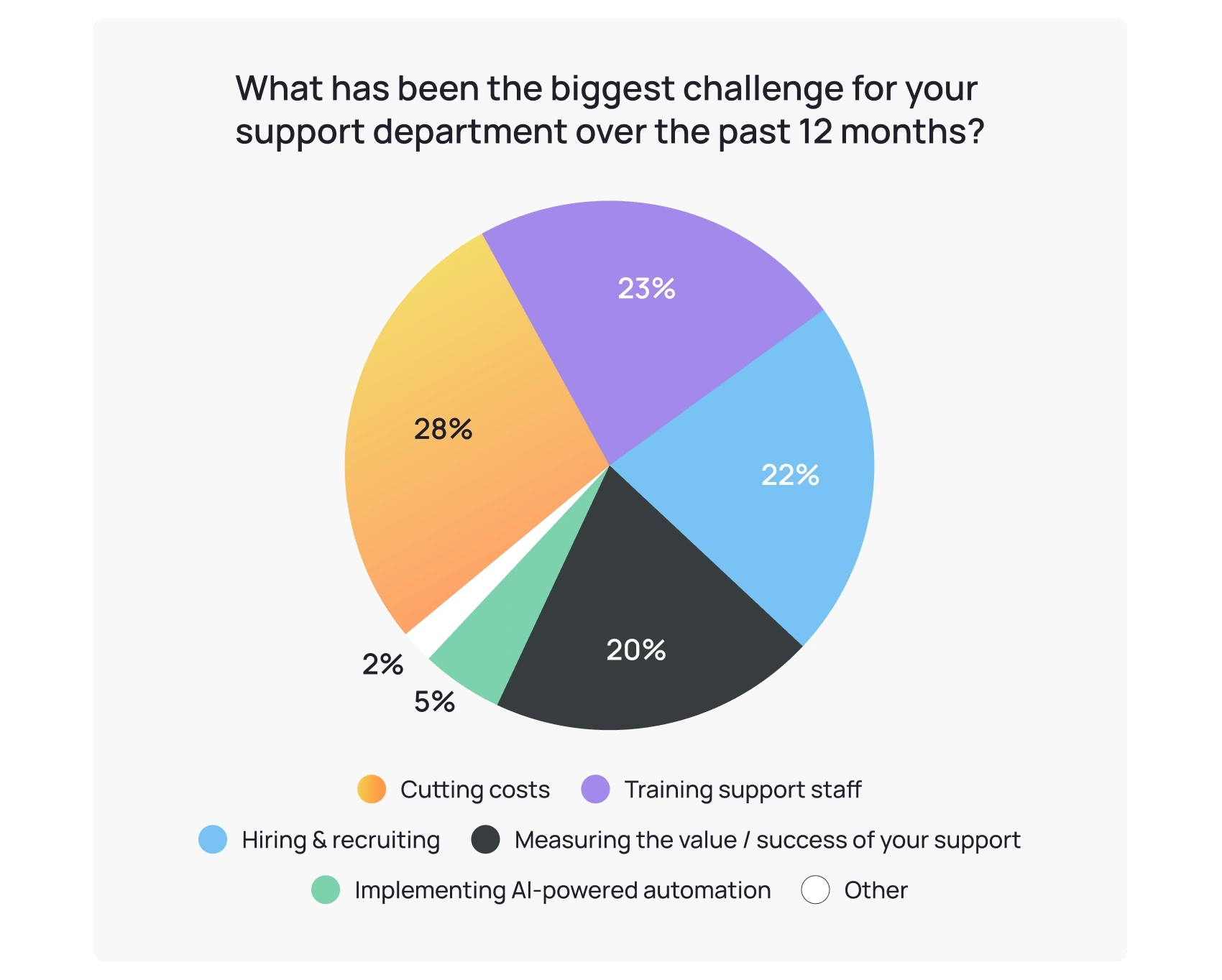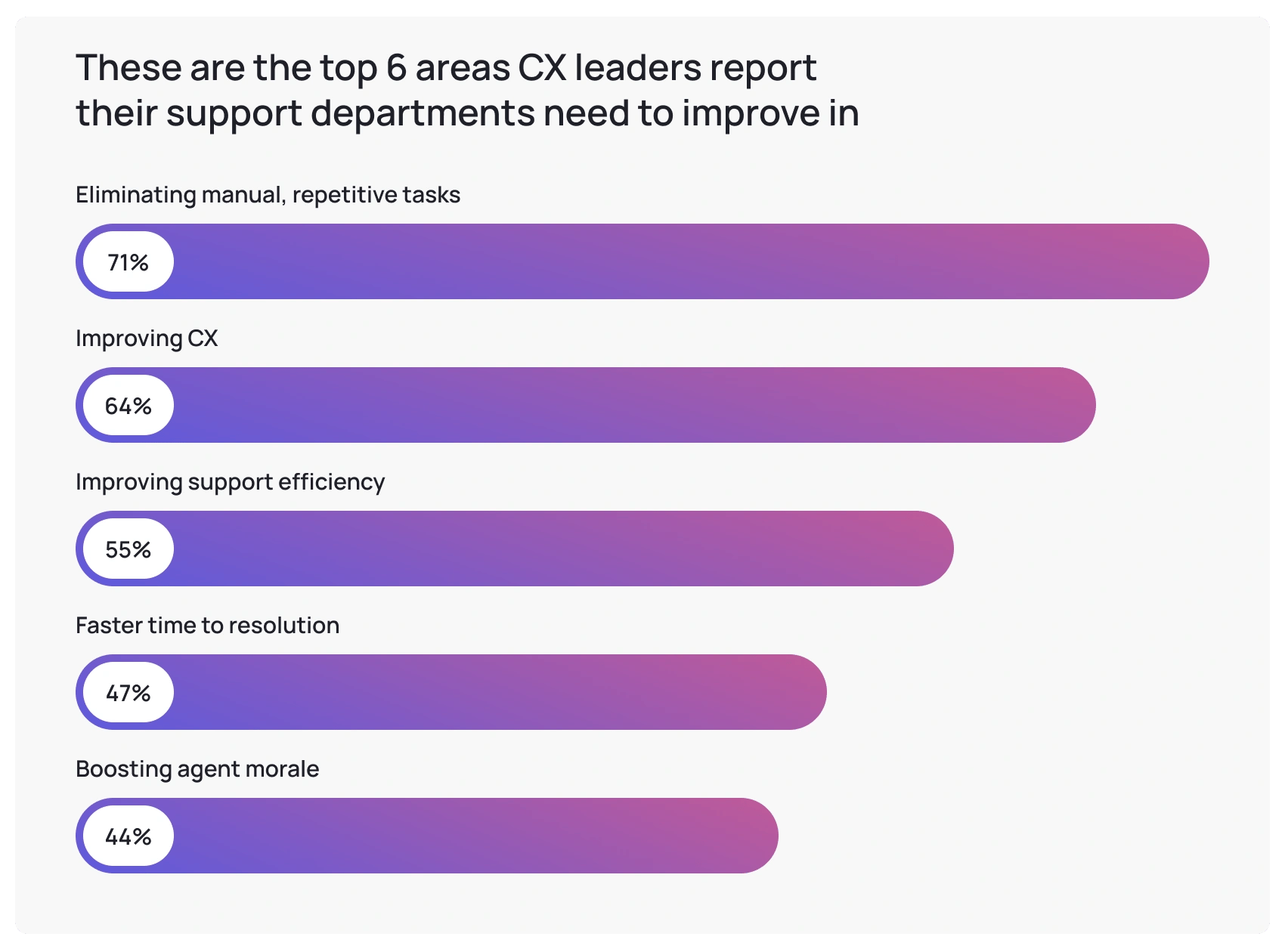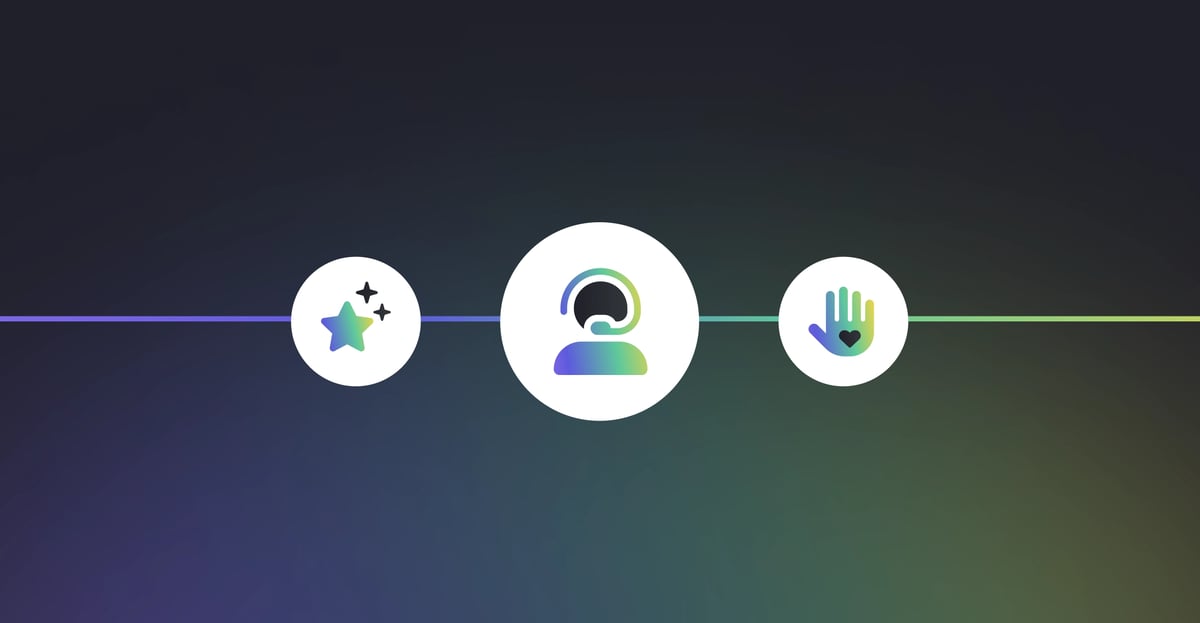The customer support landscape is rapidly changing. And while nobody knows the future for sure, after surveying 100+ business and CX leaders at the top of their game — we’ve got a pretty good idea of where 2024 will take us. You can find all of these insights in our 2024 Customer Service Trends Guide, or read on for 3 ways to improve your customer (and agent) experience over the next 12 months.
1. Go beyond customer satisfaction
Customer expectations are higher than ever. In fact, our Customer Service Trends survey found that higher customer expectations was the #1 change in consumer behavior over the past 12 months. So what does this mean?
Satisfying your customers is no longer enough.
While customer satisfaction (CSAT) remains the most important performance metric for 43% of companies, net promoter score (NPS) is quickly gaining ground. CX leaders reported that NPS is the second most important metric they’ll track in 2024 to measure support success. This tells us that today, the businesses rising to the top go beyond satisfaction — transforming their customers into brand amplifiers. And support interactions are the fires where these amplifiers are forged.
“Customers have a vast array of options for which service or product to choose. Making sure your team lives and breathes your brand’s values in every interaction is vital. It’s in those few moments where you have the opportunity to remind customers this is why they chose you!”
- Kel Kurekgi, Senior Global Customer Experience Manager, Zapier
Want to turn customers into cheerleaders for your brand? Here’s how:
- Start tracking NPS and ROX: CSAT is great for measuring one-off interactions but this metric doesn't give a strong indication of long-term business health. To gauge the robustness of your support department, track NPS and return on experience (ROX) — a metric that calculates the profits generated by investing in customer and employee experience. This will give you a more holistic understanding of your brand’s performance and the value your support team delivers.
- Access your support team’s expertise: Agents are a vital touchpoint with customers and hold valuable insights into their behaviors and needs. So don’t leave your support department to operate in a silo. Use agents as a voice of your customers and involve them in strategic conversations around brand development. They know what resonates with your customers.
- Provide instant, on-brand, 24/7 support: 72% of people will stay loyal to businesses that deliver faster customer service — so make sure you can offer the immediate support consumers expect. To keep your CX consistent, define a tone of voice (TOV) to make sure each support interaction (whether automated or not) stays on-brand. Tip: If you want to automate your support, choose a generative AI provider that can instantly adopt your TOV and craft brand-consistent replies for agents.
2. Prioritize agent experience
Behind every great customer experience, there’s a great (read: happy and fulfilled) agent. But when your support team is faced with overwhelming volumes of the same few basic requests — it’s extremely rare for this to translate into job satisfaction.
According to our in-house market research, 45% of leaders reported that either hiring or training staff was the biggest challenge for their support department in 2023. This shows that agents are talking with their feet: looking elsewhere if companies don’t take their needs into consideration.

“When you have a burned out team, this very quickly trickles down to your customer experience. You’ll see customer satisfaction (CSAT) dropping and a lower net promoter score (NPS). As the experience worsens, you experience higher team churn.”
- Natasha Ratanshi-Stein, CEO & Founder, Surfboard
Read more insights from Natasha in this interview.
Investing in agent experience (AX) isn’t simply a nice thing to do. Happy agents translate into cold hard cash — with 68% of business leaders seeing a direct correlation between employee experience and revenue growth. Add to this the savings you’ll see across recruitment and onboarding new support staff and it becomes clear: Prioritizing AX is a smart business choice.
Tech providers are making it easier than ever to improve the experience for your support team — building agent-facing generative AI features into their platforms. These include:
- Generating on-brand suggested replies to speed up handling times and reduce agent effort
- Analyzing message sentiment and supporting agents to adjust the tone of their responses
- Summarizing long message threads to help agents get up to speed quickly when a case is escalated
Deep dive into generative AI with these multimedia resources.
But most importantly, automating repetitive tasks frees agents to focus on complex cases that require their talents. Equally, learning how to use AI tools provides support teams with opportunities to upskill — transforming draining jobs into rewarding careers as Automation Managers, Chatbot Architects, Self-Service Experience Specialists, and more.
“Recent AI innovations have led to agent-facing use cases being unlocked. Companies are developing tools and features specifically aimed at making agents’ jobs easier and more interesting — so we’re starting to see a world of stress-free support teams.”
- Kimberley Wood, VP of Customer Success, Ultimate
Here’s how to put AX front and center:
- Find tech partners who prioritize agent growth: Agent retention is one of the biggest challenges for brands today. Keep your support team happy and engaged by choosing tech providers who develop features that specifically benefit agents (like customer service software giant Zendesk, who released a new suite of agent-focused generative AI tools to elevate AX)
- Measure employee satisfaction: Just like you keep track of CX through customer feedback, have regular check-ins with your agents to keep an eye on their satisfaction levels. This will help you to identify areas where you can improve their experience and create opportunities for career progression.
- Use AI-powered automation: Nobody wants to do the same repetitive tasks each day — so let a bot take care of the manual work. Use the time (and money) saved to invest in training, provide opportunities for agents to grow their skills, and create pathways for career development. You'll see churn fall and employee satisfaction rise.
More on agent experience
3. Don’t automate at all costs
Not the advice you’d expect to hear from an automation provider? Maybe. But at Ultimate, our mission has always been to help brands provide better customer care. And automation at all costs is not the way to achieve this.
As our Co-founder Sarah Al-Hussaini warns — if an AI vendor promises automation rates of 80% in just days, that’s your cue to run in the opposite direction. The goal of automation should never be replacing human connection. Instead, businesses should use automation where it really shines: to eliminate manual, repetitive processes and requests.
“While automation can be associated with a loss of personalization, we see the opposite being true. It actually gives us new capabilities for further building out relationships with our guests.”
- Danielle DeLozier, Director of Guest Relations, HomeToGo
Ticket automation is the perfect solution to balance speedy resolutions with personal connections. By taking over tasks like tagging, routing, and pre-filling, ticket automation helps companies deliver faster, more accurate support. And these efficiency gains give agents more time to dedicate to complex cases that require their empathy and problem-solving skills.

Here’s how to see the best results with ticket automation:
- Automate backend processes: When you think of support automation your mind most likely goes to customer-facing interactions, but the behind-the-scenes processes are equally important. Take time to automate workflows in your backend to enable instant ticket tagging, routing, triaging, and more. This will rapidly reduce average handling times.
- Automate the low-hanging fruit first: Start with the use cases that will make the biggest impact on your support operations. These might include things like password resets, order status confirmations, or address changes that are ideal for automation.
- Practice good email automation hygiene: A key dimension of ensuring email automation success is helping your bot to cut through all the content clutter associated with this medium. This means using a data cleaning tool like webform that helps filter out spam and internal agent emails.
Bonus tip: Go hybrid to give your customers the best of both worlds
In the spirit of giving, here’s an extra tip for free. Well — you can actually get all of these tips and more in our (entirely free) 2024 Customer Service Trends guide.
Our final recommendation for how to improve your customer service in 2024: embrace the hybrid approach to support automation. What do we mean by the hybrid approach? We’re talking about embedding generative AI into existing automation tools — to combine the ease and flexibility of gen AI with the precision and control of conversation design.
“I think the future will be this blend of generative AI and conversation design — where it’s easy to build hyper-conversational use cases, without losing control.”
- Reetu Kainulainen, CEO & Co-founder, Ultimate
Check out this free event to learn more about the hybrid approach to support automation.
If you’re looking to level up your support, look no further than our 2024 Customer Service Trends guide. Filled with data-driven predictions, expert insights, real-world case studies, and actionable takeaways, this guide will help you to deliver faster, better customer service in 2024 and beyond.
